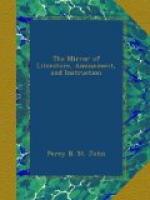“The funds of this hospital are very ample; for, after providing the master (the present Earl of Guildford)[8] with a liberal sinecure, supporting the brethren and servants, and upholding the very extensive buildings, there are distributed the following ‘doles:’
“On the 3rd of May, 10th of August, and the eve of the festivals of Easter, Whitsuntide, and Christmas, annually, the whole of the brethren and the steward of the house assemble and form two lines or ranks, at sunset, within the door of the outer gateway; when, to every person (even to infants) who applies at the gate, is given a loaf of brown bread, weighing about three pounds. This distribution is continued until all the bread is given away; and if the applicants should exceed the loaves in number, to each of the remaining persons is given an halfpenny, be they ever so numerous.
“These ‘doles’ are very beneficial to the poor of Winchester and vicinity; for to all who attend and obtain an early admission a loaf is given. I know, that when I was a boy, and never missed going to the ‘doles,’ some families, where the children were numerous, received from seven to ten loaves.
“Likewise every traveller who applies at the porter’s lodge at the outer gate of this hospital is entitled to, and receives, a horn of good beer and a loaf or slice of bread. This demand is frequently made by persons of a different quality from that intended by the founder, for the sake of attesting the peculiarity of the custom. The quantity of bread given to each person is about four ounces—of beer about three-fourths of a pint.”
We next proceed to describe the exterior of the venerable church: the interior will form the subject of a future article.
On entering the second court the first object that usually attracts attention is the Church of St. Cross, which extends a considerable distance into the court, and destroys its regularity on the east side. The exterior of the church is not altogether imposing. “The windows, with one exception, are seen to disadvantage from without, and the whole building is enveloped in a shroud of yellow gravelly plaister, strangely dissonant with ideas of Norman masonry."[9] The church is built in the cathedral form, with a nave and transept, and a low and massive tower, rising from the intersection: the whole length of the church is 150 feet; the length of the transept is 120 feet. The architecture of this structure is singularly curious, and deserving the attention of the antiquary, as it appears to throw a light on the progress, if not on the origin, of the pointed or English style. Our Correspondent states the whole to have been repaired about twenty-two years since, at a very considerable expense.
[3] Milner’s Winchester, vol. ii. p. 141.
[4] Life of Wykeham.
By Allan Cunningham—in the Family Library.
The
reference to the “four masters”
is evidently an error.




